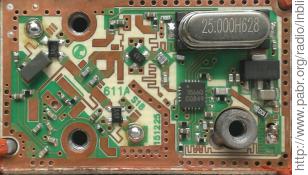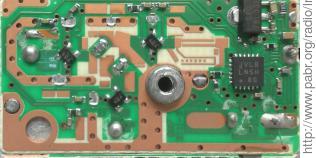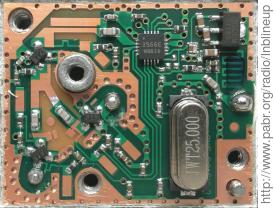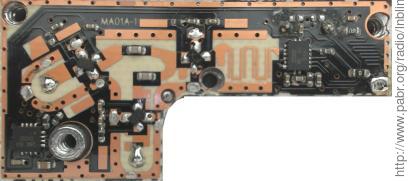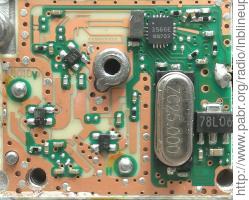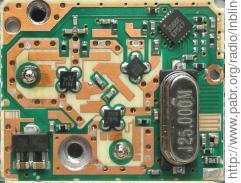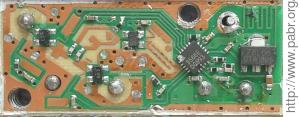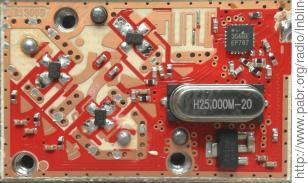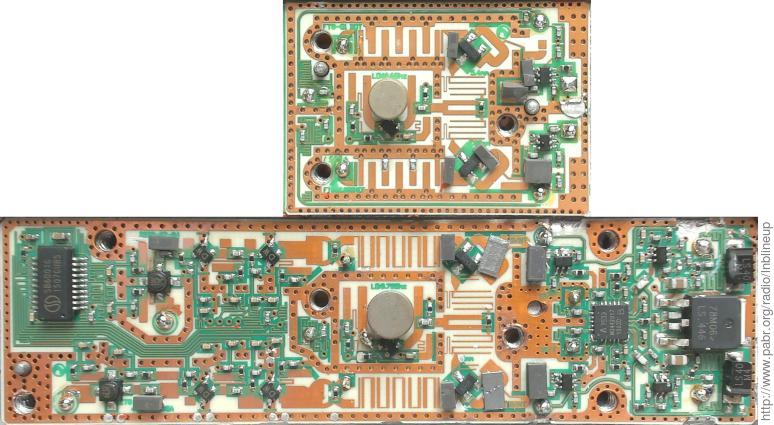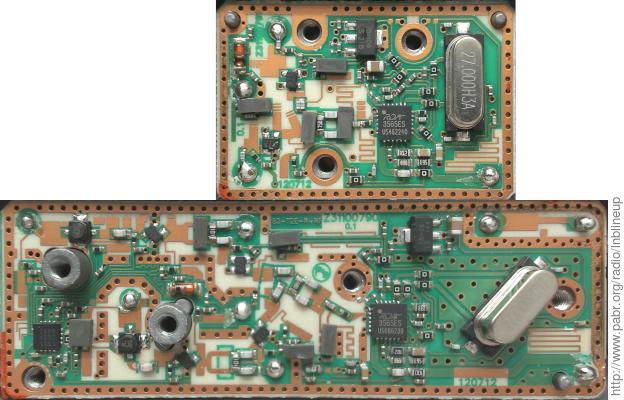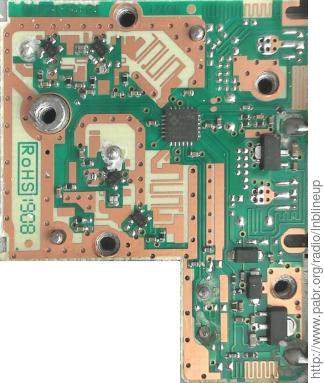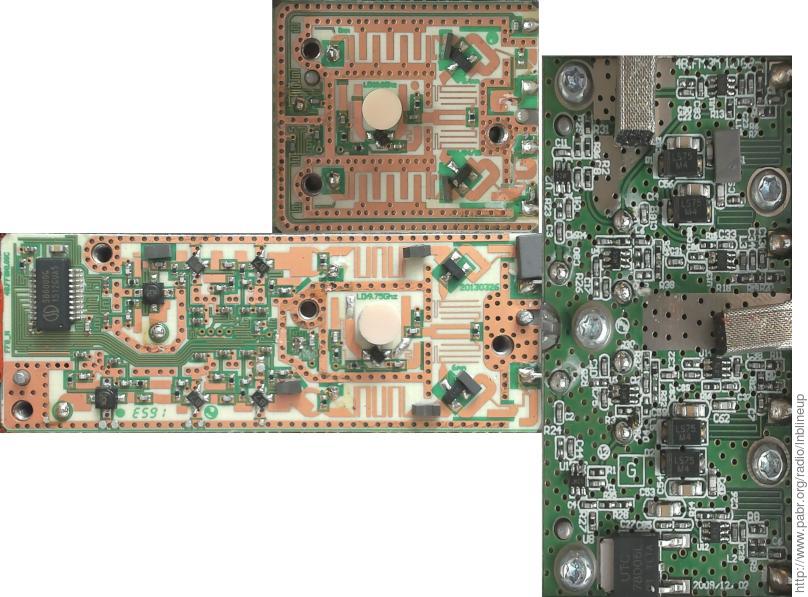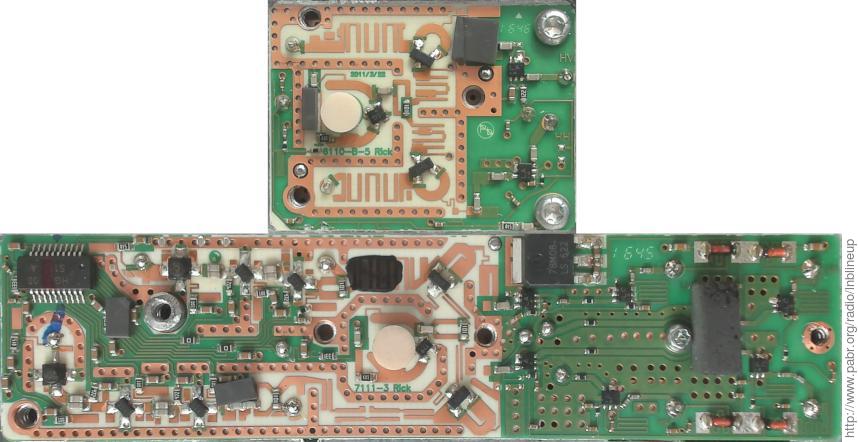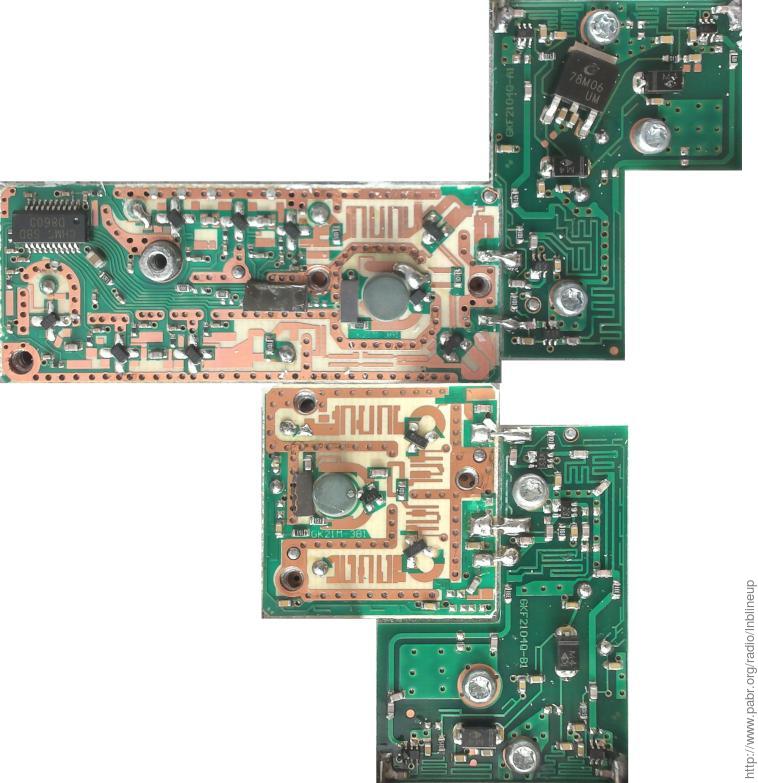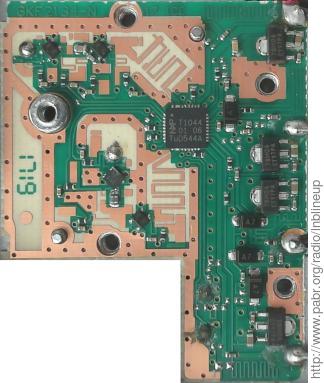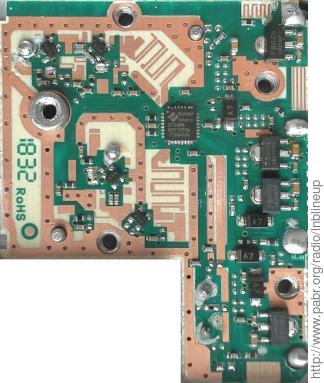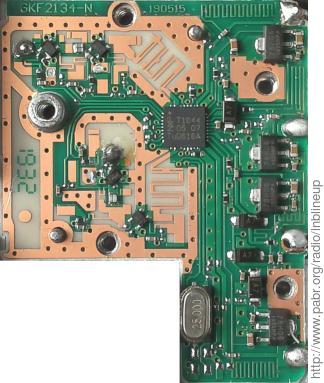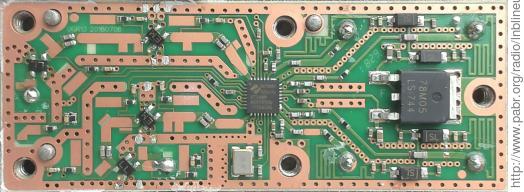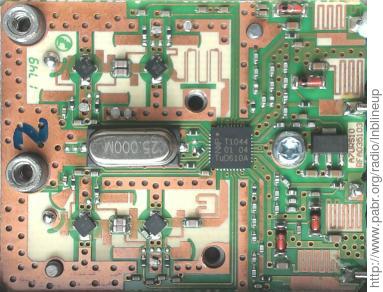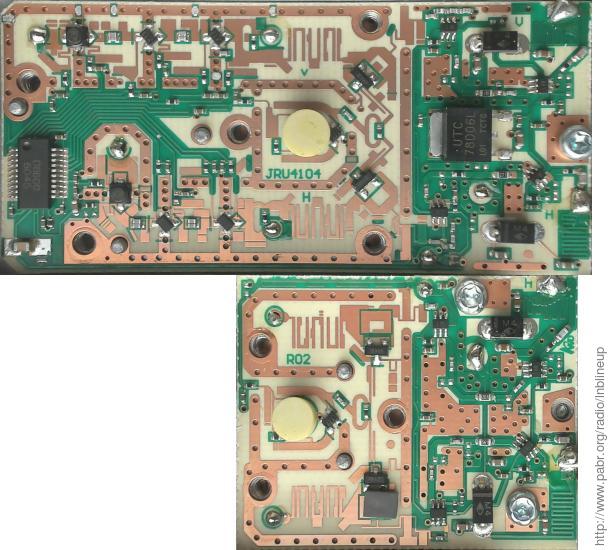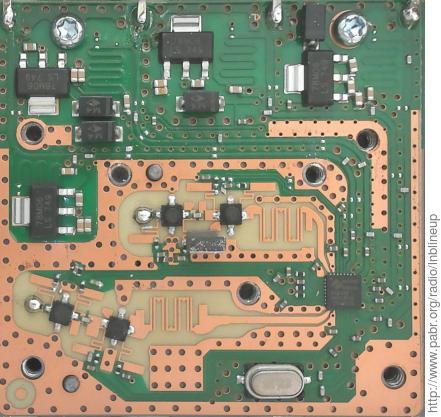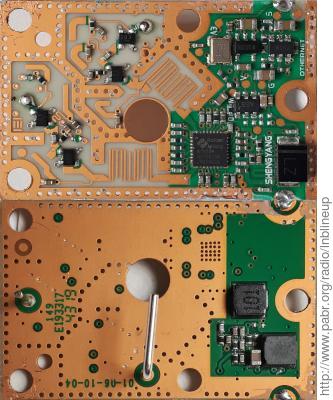I recently disassembled several inexpensive LNBs in order to select models suitable for specific modifications and applications such as:
Installing a crystal with a slightly different frequency. This may help receive the amateur 3 cm band with off-the-shelf satellite TV receivers.
Replacing the crystal with a more accurate TCXO or OCXO. This is convenient for receiving narrow-band transmissions.
Using an external clock reference. This may be useful for radioastronomy applications.
Supplying power without a bias tee.
Mounting several LNBs close together.
These concerns are mostly about mechanical construction and ease of access to key components. RF performance was not considered at all.
Hopefully these notes and pictures will be of interest to others:
Radio amateurs with unusual requirements may find this information useful to choose among an abundance of models, as the first amateur 3 cm geostationary relays are expected to be deployed soon.
Those trained in the dark art of microwave engineering may be entertained by the fascinating variety of microstrip patterns found inside these devices.
Mass-market product designers may find it interesting to identify all the small decisions which ultimately lead to significant price differences between models with mostly identical specifications.
There is a long tradition of adapting mass-market LNBs for amateur radio, starting probably with U.S. C-band TVRO equipment in the late 1970s. Articles can be found in amateur radio journals.
One popular online resource with information about other LNBs is https://uhf-satcom.com/blog/ku-band-pll-lnb-s.
All LNBs examined here are of the so-called European "Universal" type, i.e. they can receive all four sub-bands resulting from combinations of two polarizations (horizontal / vertical) and two frequency ranges (low / high). In the U.S. they are sometimes called "LNBF" (LNB and Feedhorn), possibly because early C-band equipment had separate horns and LNBs.
Technically their frequency coverage is mostly in X band (8..12 GHz), but the fixed-satellite service in Europe is commonly considered to be an extension of Ku band (12..18 GHz). Hence, these products are marketed as "Ku-band LNBs".
A "Single" LNB is powered through the same F-type coaxial connector that carries its output signal. It provides one of the four sub-bands depending on the DC component and optional overtone in the power supply:
13 V selects vertical polarization.
18 V selects horizontal polarization.
No overtone selects the 9.75 GHz LO. This downconverts the low range (10.70..11.70 GHz) to 950..1950 MHz.
A 22 kHz overtone selects the 10.60 GHz LO. This downconverts the high range (11.70..12.75 GHz) to 1100..2150 MHz.
A "Twin" LNB has two F-type connectors and behaves like two independent "Single" LNBs. If one of the connectors does not receive power, it will not output an IF signal.
A "Quad" LNB is like a "Twin" LNB, except with four independent outputs. Similarly, an "Octo" LNB offers eight independent outputs.
A "Quattro" LNB ouputs all four sub-bands, each on a dedicated connector. As long as at least one connector receives power, all four outputs are active.
Most LNBs have a 40 mm diameter neck that fits inside a bracket attached to the dish. The LNB can be rotated to account for polarization skew. LNBs with a long neck can also be moved along the main axis to match the focal length of the reflector.
"Bullet"-style LNBs are intended for multi-satellite setups where two or more horns must be packed tightly in the focal region of a single dish. They typically have a 23 mm diameter neck and a narrow dielectric lens instead of a wide horn.
Mainstream LNBs generate their LO frequency either with a dielectric resonator oscillator (DRO) or with a crystal-driven phase-locked loop (PLL). PLLs are generally preferred due to their better frequency stability (about 25 kHz vs 250 kHz). However, both technologies exhibit significant temperature-dependent drift.
One notable feature of DROs is that they can be retuned simply by turning a screw that is often accessible without disassembling the sealed cover.
Crystals are known to age; their resonant frequency can drift by several ppm per year.
Each PLL IC is rated for a specific reference frequency, typically 25 MHz. Datasheets rarely specify limits on that value. The only way to determine how much a LNB can be "pulled" up or down in frequency is by testing.
Most manufacturers claim a N.F. of 0.1 dB, which is commonly regarded as unrealistic.
There are reports that some LNBs can output as much as 20 dBm (100 mW) under saturation. This can be a concern when connecting directly to some receivers.
Table 1. Maximum rated input power for popular SDR receivers
| PlutoSDR (AD9363) | 2.5 dBm |
| RTL-SDR (R820T) | 10 dBm ? |
| LimeSDR (LMS7002M) | 2 dBm ? (0.8 Vpp 50 ohm) |
All modern "Single" LNBs turned out to be PLL-based, even those not explicitly advertized as such.
Surprisingly, many "Twin" and "Quattro" models still used DROs in 2018. It is unclear whether there is a technical reason for this, or whether manufacturers are not refreshing their product lines because the market for these models is smaller.
Most PLL models use a 25 MHz crystal. Only those based on RDA chips have a 27 MHz reference, which implies fractional PLL ratios to produce 9750 MHz and 10600 MHz.
For a given output frequency, a fractional-N PLL can perform better than an integer-N PLL because it can use a higher reference frequency. But this is not what's being done in these 27 MHz models; this raises concerns about spurious noise.
Most models are very similar in construction. Inside a plastic shell, a cast metal body forms the waveguide and cavities for one or more circuit boards. H and V probes extend from the main PCB into the waveguide, usually one straight and the other with a 90° bend.
Only a few models stand out with square waveguides, conductive mesh gaskets, weatherproof plastic shells, metric screws, or unusual mechanical configurations.
Some models have two layers of shielding: a cast metal cover on the microwave sections of the PCB, and a thin lid for the whole electronic cavity. The flexible lid clips between the walls of the chassis. On the one hand, this creates a good continuous RF seal. On the other hand, these lids are hard to remove, even after scrapping the sealing compound.
Despite a variety of board layouts and dimensions, the circuits are all very similar. The pictures below are scaled to about 40 µm per pixel (click on thumbnails for full size) and oriented so that signals flow generally from left to right. Areas without solder mask are microwave sections. The probe connections are recognizable as large solder blobs in the left half of the pictures. From there, signals go through one, two, or three stages of transistor amplification, and then into a mixer. Mixing is typically done inside the PLL IC; DRO-based models mix with transistors instead. Depending on the LNB type (Single/Twin/Quad/Quattro), one or more IF signals are selected, filtered and output via decoupling capacitors. Solder blobs on the right side lead to the F-type connectors.
Microwave sections are usually surrounded with ground traces that match the inner walls of the cast metal cover. DRO cavities are always heavily shielded.
The unlabeled grey pads in higher-end models are RF absorbers; they prevent self-oscillation and/or improve shielding between sections.
Some models have an IC near the first stage - presumably a bias voltage controller for the FET transistors.
A few models have a crystal with through-hole pins, on the hidden side of the PCB. Surface-mounted crystals are easier to replace.
The following ICs appear to be popular:
"3566". Found in almost all the low-cost models. 25 MHz PLL.
RDA 3565ES. Found in higher-end models. 27 MHz PLL, mixer, bias controller.
Rafael Micro RT320M. Found in one recent design. 25 MHz PLL, twin mixer.
NXP TFF1015HN. A 2011 IC found in one low-cost design. 25 MHz PLL, mixer. Full datasheet available, but EOL.
NXP TFF1044HN. A 2015 IC found in recent designs. Dual 25 MHz PLL, quad mixer, Quad/Quattro outputs. Full datasheet and application note available.
Rafael Micro RT348M. Found in one very recent design. Dual 25 MHz PLL, quad mixer.
Power from the coaxial connectors goes through a low-pass filter (thin wiggly line and capacitor) to a voltage regulator. All mainstream models use linear regulators, typically 78x06. Only one model was found to run at 3.3 V.
Current ratings give an indication about the maximum consumption of the LNB and/or the derating factor that the designers chose to apply:
78L06: 100 mA
78N06: 300 mA
78M06, 78D06: 500 mA
Linear regulators are less noisy than switch-mode converters, but also less efficient. A 6 V 200 mA LNB wastes 1.4 W at 13 V and 2.4 W at 18 V. Only very long, low cost steel core cables would need that much margin to compensate for voltage drop. In controlled conditions, a 9 V supply is often sufficient. However, the extra heat dissipation may be useful in wet weather.
Twin/Quad/Quattro models have either several regulators with diodes downstream, or a single regulator with diodes uptream. The latter option is less expensive but may result in more cross-talk between the IF outputs.
The BE01 stands out with a switched-mode converter followed by a linear regulator for the oscillator.
Voltage from the coaxial connectors is tapped upstream of the regulators for sub-band selection. Recent ICs implement 13/18 V and 0/22 kHz detection internally. Older designs use voltage dividers and RC filters.
Examining a large number of LNBs revealed a disturbing practice in the market: Major brands need to build a reputation over several years, but their OEM suppliers tend to renew their product lines much faster than that, typically every year. As a result, several generations of electronic designs end up being sold with the same external appearance, packaging, product name (SKU) and barcode (EAN). The changes can be as drastic as switching from a DRO to a PLL design. While this may be acceptable for mainstream consumers, it can cause headaches for users who need a durable supply of a specific design.
A few circuit boards are obviously derived from the same reference design, which is a good thing considering the expertise that goes into a microstrip board. Still, the variety of designs is surprising for a class of products with standardized specifications. No two models turned out to be rebranded clones of the same OEM product, at least not within the same geographical market.
In general, sales prices appear to reflect the complexity of the designs. It is intriguing that LNBs can be had for only a few euros, or even 1 USD if you buy a whole shipping container. The cost of the LNB is almost negligible in a satellite installation; for most consumers, it is certainly wiser to invest in a quality LNB than to climb on one's roof every few years to replace cheap units.
Most of the LNBs tested here sell for 20 EUR or less. Maybe higher-end models use completely different components families and construction techniques.
The following features can be found in more expensive devices:
C120 mounting flange for feedhorns with non-standard F/D ratios
N or SMA connectors
Better oscillator (1 ppm) for narrowband signals
Extended temperature range (-20..+70°C)
"Wideband" output (downconverting 10.70..12.75 GHz to 300..2350 MHz with a 10.40 or 10.41 GHz LO)
Custom LO frequencies
Fiber optic output
Input for external clock reference, typically 10 MHz.
Table 2. Main characteristics
| Brand | Model | Type | Neck | Crystal | PLL/Mixer | Source |
|---|---|---|---|---|---|---|
| (mm) | (MHz) | |||||
| Octagon | OSLO 1609 | Single | 40 | 25 | 3566Q EQ84 | Amazon (affiliate link) |
| McLean | MCTV-668 | Single | 40 | 25 | JVLB LN5H 8G | Amazon (affiliate link) |
| Opticum | LSP-02G | Single | 40 | 25 | 3566E NQ819 | Amazon (affiliate link) |
| Opticum | Robust | Single | 40 | 25 | T1015 04 04 SD522 | Amazon (affiliate link) |
| Diesl | Universal Single | Single | 40 | 25 | 3566E NQ703 | Amazon (affiliate link) |
| 4TV | 4TV HD | Single | 40 | 25 | 3566E EP547 | AliExpress |
| SuperHDsat | SR-320 v1 | Single | 40 | 25 | 3566E DQ693 | AliExpress |
| Star Com | SR-320 v2 | Single | 40 | 25 | 3566E DQ693 | AliExpress |
| BWEI | BT-180 | Single | 40 | 25 | 3566E EP787 | AliExpress |
| Philips | SX1019 | Single | 40 | (DRO) | Microstrip ? Diode ? | (Obsolete) |
| HD-Line | HD-BP2 | Twin | 40 | 27 | RDA 3565ES (x2) | Amazon (affiliate link) |
| Megasat | Multifeed | Twin | 23 | (DRO) | XH8 (x4) | Amazon (affiliate link) |
| Octagon | OTLSO 1306 | Twin | 40 | 27 | RDA 3565ES (x2) | Amazon (affiliate link) (25/27 MHz random) |
| Octagon | OTLSO 1609 | Twin | 40 | 25 | RT320M | Amazon (affiliate link) (25/27 MHz random) |
| HB-Digital | UHD 202 S 201901 | Twin | 40 | 25 ? | RT320 | Amazon (affiliate link) |
| Pro-Line | P-40 | Quattro | 40 | (DRO) | XH8 (x4) | Amazon (affiliate link) |
| Venton | EXL-Q | Quattro | 23 | (DRO) | XH8 (x4) | Amazon (affiliate link) |
| HB-Digital | UHD 414 201612 | Quattro | 40 | (DRO) | XH8 (x4) | Amazon (affiliate link) (DRO/PLL random) |
| HB-Digital | UHD 414 201705 | Quattro | 40 | 25 ? | NXP T1044 | Amazon (affiliate link) (DRO/PLL random) |
| HB-Digital | UHD 414 201808 | Quattro | 40 | 25 ? | RT348M | Amazon (affiliate link) (DRO/PLL random) |
| HB-Digital | UHD 414 201909 | Quattro | 40 | 25 | NXP T1044 | Amazon (affiliate link) (DRO/PLL random) |
| Triax | 304832 | Quattro | 40 | 25 | RT348M | |
| Opticum | LRP-04H | Quattro | 40 | 25 | NXP T1044 | Amazon (affiliate link) |
| PremiumX | Deluxe Quattro | Quattro | 40 | (DRO) | 4R S 64 (x2), 4R S 59 (x2) | Amazon (affiliate link) |
| Inverto | 5448 | Quattro | 40 | 25 | RT348M | |
| Othernet | Bullseye BE01 | Single | 40 | 25 | RT320M |
(Click image to enlarge)
This is an inexpensive model with a simpler design than its "Twin" variant (OTLSO).
Interestingly, the PCB is tilted at 45°. As a result, both probes have identical 45° bends, whereas most LNBs have one straight probe and the other bent at 90°. Maybe this is done to ensure balanced performance between the two polarizations, or to reduce the length of the slits through which the probes enter the waveguide.
Related model . There are reports of an earlier version labeled "1301", identical to the Avenger PLL321S. It uses a RDA3560M and a 27 MHz crystal. Useful links:
Analysis of PLL321S: http://f1chf.free.fr/LNBPLL/inside.pdf
Various mods and measurements: http://www.hb9afo.ch/articles/pll-lnb/10ghz_pll-lnb.htm
Related model . There is also a version labeled "1404" (details unknown).
Table 3. Octagon OSLO 1609 data
| Type | Single | |
| Unit price (approx) | 8 | EUR,USD |
| Neck diameter | 40 | mm |
| Neck length | 30 | mm |
| Aperture diameter | ~50 | mm |
| Cap diameter | 62 | mm |
| Rated noise factor | 0.1 | dB |
| Rated gain | 65 | dB |
| Rated flatness/26MHz | dB | |
| PCB size | 35x21 | mm² |
| Stage 1 | 103 (x2) | |
| Stage 2 | 103 | |
| Crystal | 25.000H628 | |
| PLL/mixer IC | 3566Q EQ84 | |
| Regulator | 78N06G | |
| Screws | 3 | |
| RF pads | 1 | |
| Labels | CE, WEEE |
(Click image to enlarge)
This is an intriguing model with an unidentified PLL/mixer IC running at 3.3 V. The through-hole crystal is mounted on the back side.
Table 4. McLean MCTV-668 data
| Type | Single | |
| Unit price (approx) | 6 | EUR,USD |
| Neck diameter | 40 | mm |
| Neck length | 28 | mm |
| Aperture diameter | ~47 | mm |
| Cap diameter | 53 | mm |
| Rated noise factor | 0.1 | dB |
| Rated gain | 65 | dB |
| Rated flatness/26MHz | 0.5 ? | dB |
| PCB size | 35x19 | mm² |
| Stage 1 | V84 (x2) | |
| Stage 2 | V84 | |
| Crystal | 25.000M08 | |
| Rated L.O. accuracy | 1000 ? | kHz |
| over temperature range | 2000 ? | kHz |
| PLL/mixer IC | JVLB LN5H 8G | |
| Regulator | 78L33 | |
| Rated current | 80 ? | mA |
| Screws | 2 | |
| Labels | CE, WEEE |
(Click image to enlarge)
This a basic model, compact and inexpensive.
Table 5. Opticum LSP-02G data
| Type | Single | |
| Unit price (approx) | 6 | EUR,USD |
| Neck diameter | 40 | mm |
| Neck length | 30 | mm |
| Aperture diameter | ~40 | mm |
| Cap diameter | 50 | mm |
| Rated noise factor | 0.1 | dB |
| Rated gain | 60 | dB |
| Rated flatness/26MHz | dB | |
| PCB size | 31x25 | mm² |
| Stage 1 | V75 (x2) | |
| Stage 2 | V75 | |
| Crystal | JWT25.000 | |
| PLL/mixer IC | 3566E NQ819 | |
| Regulator | 78S06M | |
| Screws | 3 | |
| Labels | CE, WEEE |
(Click image to enlarge)
This model has a small non-rectangular circuit board. The through-hole crystal is mounted on the back side.
The PLL/mixer is the well-documented NXP TFF1015HN.
Related model . Apparently sold as Amiko L-107 in the U.S.A.
Related model . The Goobay 67321 has a rectangular PCB with an almost identical layout and a SMD crystal.
Table 6. Opticum Robust data
| Type | Single | |
| Unit price (approx) | 6 | EUR,USD |
| Neck diameter | 40 | mm |
| Neck length | 36 | mm |
| Aperture diameter | ~50 | mm |
| Cap diameter | 56 | mm |
| Rated noise factor | 0.1 | dB |
| Rated gain | dB | |
| Rated flatness/26MHz | dB | |
| PCB size | 47x22 | mm² |
| Bias IC | CHMC SE4 D4202 | |
| Stage 1 | V75 (x2) | |
| Stage 2 | FX | |
| Crystal | J25F6S8 | |
| PLL/mixer IC | T1015 04 04 SD522 | |
| Regulator | ||
| Screws | 3 | |
| Labels | CE, WEEE |
(Click image to enlarge)
This is a basic model, compact and inexpensive, but with interesting microstrip patterns.
The waveguide has a square cross-section.
Related model . The Sharp BS1K1EL100A has a similar board layout, but a different PLL/mixer IC.
Table 7. Diesl Universal Single data
| Type | Single | |
| Unit price (approx) | 6 | EUR,USD |
| Neck diameter | 40 | mm |
| Neck length | 26 | mm |
| Aperture diameter | ~50 | mm |
| Cap diameter | 60 | mm |
| Rated noise factor | 0.1 | dB |
| Rated gain | dB | |
| Rated flatness/26MHz | dB | |
| PCB size | 28x24 | mm² |
| Stage 1 | 103 (x2) | |
| Stage 2 | 103 | |
| Crystal | ZC25.000 | |
| PLL/mixer IC | 3566E NQ703 | |
| Regulator | 78L06 | |
| Screws | 4 | |
| RF pads | 1 | |
| Labels |
(Click image to enlarge)
This is a basic model with the distinguising feature that the cast metal enclosure is not sealed. Instead, the plastic shell is weatherproof (and hard to disassemble). Also, the F-type connector is attached to the cover rather than to the main body.
Related model . Apparently also sold as "LNB G110".
Table 8. 4TV 4TV HD data
| Type | Single | |
| Unit price (approx) | 4 | EUR,USD |
| Neck diameter | 40 | mm |
| Neck length | mm | |
| Aperture diameter | ~36 | mm |
| Cap diameter | 56 | mm |
| Rated noise factor | 0.1 | dB |
| Rated gain | 60 | dB |
| Rated flatness/26MHz | dB | |
| PCB size | 27x22 | mm² |
| Stage 1 | 3513 FK46 (x2) | |
| Stage 2 | 3513 FK46 | |
| Crystal | J25.000M | |
| PLL/mixer IC | 3566E EP547 | |
| Regulator | 78L06 | |
| Screws | 2 | |
| Labels | CE |
(Click image to enlarge)
A ultra-low-cost model. The unit I examined had a missing screw hidden by the sealant compound. No CE mark.
Related model . There is a completely different model also branded as "SR-320": Section 6.8, “Star Com SR-320 v2”.
Table 9. SuperHDsat SR-320 v1 data
| Type | Single | |
| Unit price (approx) | 3 | EUR,USD |
| Neck diameter | 40 | mm |
| Neck length | 30 | mm |
| Aperture diameter | ~40 | mm |
| Cap diameter | 60 | mm |
| Rated noise factor | 0.1 | dB |
| Rated gain | 65 | dB |
| Rated flatness/26MHz | dB | |
| PCB size | 47x15 | mm² |
| Stage 1 | 10F (x2) | |
| Stage 2 | 10F | |
| Crystal | 25.000 | |
| PLL/mixer IC | 3566E DQ693 | |
| Regulator | 78L06 | |
| Screws | 3 | |
| Labels |
(Click image to enlarge)
This is a ultra-low-cost model. The through-hole crystal is mounted on the back side. The unit I examined had insufficient sealing. No CE mark.
Related model . There is a completely different model also branded as "SR-320": Section 6.7, “SuperHDsat SR-320 v1”.
Table 10. Star Com SR-320 v2 data
| Type | Single | |
| Unit price (approx) | 3 | EUR,USD |
| Neck diameter | 40 | mm |
| Neck length | 27 | mm |
| Aperture diameter | ~48 | mm |
| Cap diameter | 61 | mm |
| Rated noise factor | 0.1 | dB |
| Rated gain | dB | |
| Rated flatness/26MHz | dB | |
| PCB size | 34x14 | mm² |
| Stage 1 | 10x | |
| Stage 2 | 10T | |
| Crystal | EE25.000M | |
| PLL/mixer IC | 3566E DQ693 | |
| Regulator | 78L06 | |
| Screws | 2 | |
| Labels |
(Click image to enlarge)
This is a ultra-low-cost LNB, with a plain layout but otherwise using the same components as the others. Comes unbranded and without a CE mark.
Table 11. BWEI BT-180 data
| Type | Single | |
| Unit price (approx) | 2.5 | EUR,USD |
| Neck diameter | 40 | mm |
| Neck length | 42 | mm |
| Aperture diameter | ~50 | mm |
| Cap diameter | 60 | mm |
| Rated noise factor | 0.1 | dB |
| Rated gain | 58-65 | dB |
| Rated flatness/26MHz | dB | |
| PCB size | 35x22 | mm² |
| Stage 1 | V75 (x2) | |
| Stage 2 | V75 | |
| Crystal | H25.000M-20 | |
| PLL/mixer IC | 3566E EP787 | |
| Regulator | 78S06 | |
| Screws | 4 | |
| Labels |
(Click image to enlarge)
This is a historical model made in Germany, possibly in the late 1990s or early 2000s. The plastic shell is weatherproof and welded around the F-type connector. The thin circuit board is riveted between the main body and a backing shield. Probes are apparently gold plated and held in place by PTFE washers. The main IC is a ZNBG3113 bias controller and I.F. switch.
Table 12. Philips SX1019 data
| Type | Single | |
| Unit price (approx) | ? | EUR,USD |
| Neck diameter | 40 | mm |
| Neck length | 40 | mm |
| Aperture diameter | 47 | mm |
| Cap diameter | 59 | mm |
| Rated noise factor | ? | dB |
| Rated gain | ? | dB |
| Rated flatness/26MHz | dB | |
| PCB size | 84x25 | mm² |
| Bias IC | ZETEX ZNBG3113 0318A | |
| Stage 1 | "G" (x2) | |
| Stage 2 | "G" | |
| Stage 3 | "G" | |
| Crystal | DRO + T79 (x2) | |
| PLL/mixer IC | Microstrip ? Diode ? | |
| Regulator | 8C3Q | |
| RF pads | 2 | |
| Rivets | 11 | |
| Labels | CE |
(Click image to enlarge)
This is a sophisticated design with a nice symmetrical board layout. A single crystal apparently drives the two PLL/mixer ICs. There is free space in the enclosure near the gold-plated output connectors.
Table 13. HD-Line HD-BP2 data
| Type | Twin | |
| Unit price (approx) | 20 | EUR,USD |
| Neck diameter | 40 | mm |
| Neck length | 56 | mm |
| Aperture diameter | mm | |
| Cap diameter | 59 | mm |
| Rated noise factor | 0.1 | dB |
| Rated gain | 62 | dB |
| Rated flatness/26MHz | dB | |
| PCB size | 73x24 | mm² |
| Bias IC | D8400 3063 | |
| Stage 1 | 3Y C A205 (x2) | |
| Stage 2 | V84 (x2) | |
| Stage 3 | t7N (x4) | |
| Crystal | H27.000M | |
| PLL/mixer IC | RDA 3565ES (x2) | |
| Regulator | 78S06M (x2) | |
| Screws | 6 | |
| Labels | CE, WEEE |
(Click image to enlarge)
This is a "bullet"-style LNB with a narrow head and 23 mm diameter neck followed by a 40 mm diameter section. The two circuit boards are quite sophisticated, but use DROs. Four transistor-based mixers feed into an AMICCOM A7533 switch.
The dielectric lens clips onto a thin flange of inner diameter 19.2 mm, outer diameter 27.2 mm.
Table 14. Megasat Multifeed data
| Type | Twin | |
| Unit price (approx) | 17 | EUR,USD |
| Neck diameter | 23 | mm |
| Neck length | 31 | mm |
| Aperture diameter | mm | |
| Cap diameter | 30 | mm |
| Rated noise factor | 0.1 | dB |
| Rated gain | dB | |
| Rated flatness/26MHz | dB | |
| PCB size | 91x25 + 37x26 | mm² |
| Bias IC | SB6001G 1507GUB5 | |
| Stage 1 | 53 C A042 (x2) | |
| Stage 2 | DW (x2) | |
| Stage 3 | DW (x2) | |
| Crystal | DRO + NDt (x2) | |
| PLL/mixer IC | XH8 (x4) | |
| Regulator | 78M06 | |
| Screws | 9 | |
| RF pads | 20 | |
| Labels | CE |
(Click image to enlarge)
This model is popular in the amateur radio community. The second PLL/mixer is in a dedicated shielded cavity.
Links:
TCXO mod: http://www.dg0opk.darc.de/Octagon_LNB_mod_March2017.html
External 27 MHz reference mods: http://www.earf.co.uk/ocxolnb.html, http://www.g4jnt.com/OctagonExtLo.pdf, http://microbandas.es/doku.php?id=microperlas:accesorios:lnb_disciplinado, http://www.df9np.de/Contents/TVSat_LNB.pdf
Replacement PCB for 10 MHz reference: https://loetlabor-jena.de/doku.php?id=projekte:3cmplllnb:start
Related model . Apparently sold as Amiko L-203 in the U.S.A.
Related model . As of October 2018, this model can still be found in the supply chain, but a completely redesigned variant is being rolled out with the same product name and SKU: Section 6.14, “Octagon OTLSO 1609”. "1306" and "1609" refer to markings near the CE logo on the sticker.
Related model . There are also reports of an earlier, almost identical version labeled "1301", possibly with a RDA3560M instead of the RDA3565ES.
Table 15. Octagon OTLSO 1306 data
| Type | Twin | |
| Unit price (approx) | 15 | EUR,USD |
| Neck diameter | 40 | mm |
| Neck length | 54 | mm |
| Aperture diameter | ~50 | mm |
| Cap diameter | 62 | mm |
| Rated noise factor | 0.1 | dB |
| Rated gain | 60 - 65 | dB |
| Rated flatness/26MHz | dB | |
| PCB size | 73x24 + 36x24 | mm² |
| Bias IC | ZABG 4002 1251 | |
| Stage 1 | 29 C A373 (x2) | |
| Stage 2 | V75 (x2) | |
| Stage 3 | V75 (x4) | |
| Crystal | 27.000 (x2) | |
| PLL/mixer IC | RDA 3565ES (x2) | |
| Regulator | 78H06 (x2) | |
| Metric screws | 5+3 | |
| RF pads | 8+7 | |
| Labels | CE |
(Click image to enlarge)
This is a redesign of the OTLSO, identified by "1609" near the CE mark on the sticker. Only two stages of transistor amplification, twin-mixer IC, 25 MHz crystal instead of 27 MHz. The board layout is simple and elegant thanks to the dedicated Rafael Micro IC, although it has obviously been tailored to fit in the same cast metal enclosure as the earlier variant.
Related model . Section 6.13, “Octagon OTLSO 1306 (Amiko L-203)”
Table 16. Octagon OTLSO 1609 data
| Type | Twin | |
| Unit price (approx) | 15 | EUR,USD |
| Neck diameter | 40 | mm |
| Neck length | 54 | mm |
| Aperture diameter | ~50 | mm |
| Cap diameter | 62 | mm |
| Rated noise factor | 0.1 | dB |
| Rated gain | 60 - 65 | dB |
| Rated flatness/26MHz | dB | |
| PCB size | 72x23 | mm² |
| Stage 1 | FET (x2) | |
| Stage 2 | 103 (x2) | |
| Crystal | 25.000H629 | |
| PLL/mixer IC | RT320M | |
| Regulator | 78N06G (x2) | |
| Metric screws | 5 | |
| RF pads | 3 | |
| Labels | CE, WEEE |
(Click image to enlarge)
A modern Twin PLL model with a clean layout.
Related model . Very similar to the UHD 414 201705 (Section 6.19, “HB-Digital UHD 414 201705 (Gecen GKF-2134-N ?)”), except with a Rafael Micro RT320 IC.
Related model . The Octagon OQSLG (Quad) has an almost identical layout with a Rafael Micro RT340 IC and other transistors.
Table 17. HB-Digital UHD 202 S 201901 data
| Type | Twin | |
| Unit price (approx) | 13 | EUR,USD |
| Neck diameter | 40 | mm |
| Neck length | 42 | mm |
| Aperture diameter | 47 | mm |
| Cap diameter | 55 | mm |
| Rated noise factor | 0.1 | dB |
| Rated gain | dB | |
| Rated flatness/26MHz | dB | |
| PCB size | 37x46 | mm² |
| Bias IC | ||
| Stage 1 | A5T (x2) | |
| Stage 2 | A5M (x2) | |
| Crystal | 25 ? | |
| Rated L.O. accuracy | kHz | |
| over temperature range | kHz | |
| PLL/mixer IC | RT320 | |
| Regulator | 78H06 (x2) | |
| Rated current | mA | |
| Screws | 5 | |
| RF pads | 3 | |
| Labels | CE |
(Click image to enlarge)
A sophisticated design with RF gaskets and two layers of shielding, but with DROs rather than PLLs. Four transistor-based mixers feed into a dedicated PCB with the Quattro outputs.
Table 18. Pro-Line P-40 data
| Type | Quattro | |
| Unit price (approx) | 18 | EUR,USD |
| Neck diameter | 40 | mm |
| Neck length | 37 | mm |
| Aperture diameter | mm | |
| Cap diameter | 62 | mm |
| Rated noise factor | dB | |
| Rated gain | dB | |
| Rated flatness/26MHz | dB | |
| PCB size | 65x24 + 32x28 + 30x65 | mm² |
| Bias IC | SB6000G 1512GUA5 | |
| Stage 1 | 68 C A103 (x2) | |
| Stage 2 | B7 (x4) | |
| Crystal | DRO + NEt (x2) | |
| PLL/mixer IC | XH8 (x4) | |
| Regulator | 78D06L | |
| Screws | 4 | |
| Metric screws | 6 | |
| Labels | CE |
(Click image to enlarge)
A sophisticated "bullet" model with two layers of shielding, but with DROs rather than PLLs. It has a short 23 mm diameter neck followed by a 40 mm diameter section. Interesting use of some kind of ink to tune one microstrip pattern.
Table 19. Venton EXL-Q data
| Type | Quattro | |
| Unit price (approx) | 14 | EUR,USD |
| Neck diameter | 23 | mm |
| Neck length | 22 | mm |
| Aperture diameter | mm | |
| Cap diameter | 30 | mm |
| Rated noise factor | 0.1 | dB |
| Rated gain | dB | |
| Rated flatness/26MHz | dB | |
| PCB size | 101x25 + 37x28 | mm² |
| Bias IC | HG 6000 S1428A | |
| Stage 1 | 61 C A113 (x2) | |
| Stage 2 | V75 (x4) | |
| Crystal | DRO + T79/GG (x2) | |
| PLL/mixer IC | XH8 (x4) | |
| Regulator | 78M08 | |
| Screws | 9 | |
| RF pads | 13 | |
| Labels | CE |
(Click image to enlarge)
A compact and inexpensive Quattro model.
The circuit is spread over four boards, presumably to minimize the area of expensive low-loss substrate for the microwave sections.
Related model . There is a more recent version with the same name and SKU but a PLL circuit: Section 6.19, “HB-Digital UHD 414 201705 (Gecen GKF-2134-N ?)”. The four F-type connectors are rotated 180°; there are no other external differences except the serial numbers.
Table 20. HB-Digital UHD 414 201612 data
| Type | Quattro | |
| Unit price (approx) | 10 | EUR,USD |
| Neck diameter | 40 | mm |
| Neck length | 42 | mm |
| Aperture diameter | 47 | mm |
| Cap diameter | 55 | mm |
| Rated noise factor | 0.1 | dB |
| Rated gain | 60 ? | dB |
| Rated flatness/26MHz | 0.5 ? | dB |
| PCB size | 89x46 + 44x48 | mm² |
| Bias IC | CHMC SBD D8600 | |
| Stage 1 | V75 (x2) | |
| Stage 2 | V75 (x2) | |
| Stage 3 | V75 (x2) | |
| Crystal | DRO + T79 (x2) | |
| Rated L.O. accuracy | kHz | |
| over temperature range | kHz | |
| PLL/mixer IC | XH8 (x4) | |
| Regulator | 78M06 | |
| Rated current | mA | |
| Screws | 7 + 5 | |
| RF pads | 4 | |
| Labels | CE |
(Click image to enlarge)
A modern Quattro PLL model with a clean layout thanks to the dedicated NXP IC. The through-hole crystal is mounted on the back side.
A notch in the top sidewall makes it easy to lift the cover.
The Low/H output is noisier than the other three. Maybe this is related to the fact that vertical polarization uses a different (better ?) first-stage transistor.
Related model . There is an earlier version with the same name and SKU but a DRO circuit: (Section 6.18, “HB-Digital UHD 414 201612 (Gecen GKF-2104Q ?)”).
Related model . There is a more recent version with the same name and SKU but a Rafael Micro IC: Section 6.20, “HB-Digital UHD 414 201808 (Gecen GKF-2134-Q ?)”. The two rearmost connectors are swapped and the housing has "UHD 4K" embossed on top.
Table 21. HB-Digital UHD 414 201705 data
| Type | Quattro | |
| Unit price (approx) | 14 | EUR,USD |
| Neck diameter | 40 | mm |
| Neck length | 42 | mm |
| Aperture diameter | 47 | mm |
| Cap diameter | 55 | mm |
| Rated noise factor | 0.1 | dB |
| Rated gain | 60 ? | dB |
| Rated flatness/26MHz | 0.5 ? | dB |
| PCB size | 37x46 | mm² |
| Bias IC | ||
| Stage 1 | H.B., 3513 116q | |
| Stage 2 | H.B. (x2) | |
| Crystal | 25 ? | |
| Rated L.O. accuracy | 1000 ? | kHz |
| over temperature range | 2000 ? | kHz |
| PLL/mixer IC | NXP T1044 | |
| Regulator | 78H06 (x4) | |
| Rated current | 220 ? | mA |
| Screws | 5 | |
| RF pads | ||
| Labels | CE |
(Click image to enlarge)
A modern Quattro PLL model with a clean layout thanks to the dedicated Rafael Micro IC. The through-hole crystal is mounted on the back side.
A notch in the top sidewall makes it easy to lift the cover.
Related model . There is an earlier, almost identical variant with the same name and SKU but a NXP IC: (Section 6.19, “HB-Digital UHD 414 201705 (Gecen GKF-2134-N ?)”).
Related model . There is a more recent version which reverts to the NXP IC: Section 6.21, “HB-Digital UHD 414 201909 (Gecen GKF-2134-N ?)”.
Table 22. HB-Digital UHD 414 201808 data
| Type | Quattro | |
| Unit price (approx) | 17 | EUR,USD |
| Neck diameter | 40 | mm |
| Neck length | 42 | mm |
| Aperture diameter | 47 | mm |
| Cap diameter | 55 | mm |
| Rated noise factor | 0.1 | dB |
| Rated gain | dB | |
| Rated flatness/26MHz | dB | |
| PCB size | 37x46 | mm² |
| Bias IC | ||
| Stage 1 | A46 (x2) | |
| Stage 2 | A46 (x2) | |
| Crystal | 25 ? | |
| PLL/mixer IC | RT348M | |
| Regulator | 78H06 (x4) | |
| Rated current | mA | |
| Screws | 5 | |
| RF pads | 3 | |
| Labels | CE |
(Click image to enlarge)
A modern Quattro PLL model with a clean layout thanks to the dedicated NXP IC.
A notch in the top sidewall makes it easy to lift the cover.
Related model . There are earlier versions with a through-hole crystal mounted on the back side, some with the same NXP IC (Section 6.19, “HB-Digital UHD 414 201705 (Gecen GKF-2134-N ?)”), some with a Rafael Micro IC (Section 6.20, “HB-Digital UHD 414 201808 (Gecen GKF-2134-Q ?)”).
Table 23. HB-Digital UHD 414 201909 data
| Type | Quattro | |
| Unit price (approx) | 14 | EUR,USD |
| Neck diameter | 40 | mm |
| Neck length | 42 | mm |
| Aperture diameter | 47 | mm |
| Cap diameter | 55 | mm |
| Rated noise factor | dB | |
| Rated gain | dB | |
| Rated flatness/26MHz | dB | |
| PCB size | 37x46 | mm² |
| Bias IC | ||
| Stage 1 | 1 0W (x2) | |
| Stage 2 | 1 0W (x2) | |
| Crystal | 25.000 | |
| Rated L.O. accuracy | kHz | |
| over temperature range | kHz | |
| PLL/mixer IC | NXP T1044 | |
| Regulator | 78H06 (x4) | |
| Rated current | mA | |
| Screws | 5 | |
| RF pads | ||
| Labels | CE |
(Click image to enlarge)
A recent, somewhat expensive model with Quattro outputs in the same form factor as a Single LNB. Beautiful board layout based on the Rafael Micro RT348M.
Its main distinguishing feature is a low-profile SMD crystal.
Table 24. Triax 304832 data
| Type | Quattro | |
| Unit price (approx) | 30 | EUR,USD |
| Neck diameter | 40 | mm |
| Neck length | 32 | mm |
| Aperture diameter | ~50 | mm |
| Cap diameter | 61 | mm |
| F/D | 0.6 | |
| Rated noise factor | 0.3 | dB |
| Rated gain | 55 - 65 | dB |
| Rated flatness/26MHz | 8 ? | dB |
| PCB size | 61x23 | mm² |
| Bias IC | ||
| Stage 1 | LL (x2) | |
| Stage 2 | EM (x2) | |
| Crystal | .25.OY | |
| over temperature range | 1500 | kHz |
| PLL/mixer IC | RT348M | |
| Regulator | 78M05 | |
| Rated current | 130? 265? | mA |
| Screws | 5 | |
| Labels | CE |
(Click image to enlarge)
An intriguing model with a heavy inner shield over the microwave section plus a thin cover for the whole electronic cavity. This is usually seen only in DRO designs.
Hard to disassemble.
Elegant layout and modern PLL/mixer IC from NXP, but the crystal is hard to reach because of the shielding.
Table 25. Opticum LRP-04H data
| Type | Quattro | |
| Unit price (approx) | 14 | EUR,USD |
| Neck diameter | 40 | mm |
| Neck length | 32 | mm |
| Aperture diameter | mm | |
| Cap diameter | 60 | mm |
| Rated noise factor | 0.1 | dB |
| Rated gain | dB | |
| Rated flatness/26MHz | dB | |
| PCB size | 44x35 | mm² |
| Stage 1 | 3513 118n (x2) | |
| Stage 2 | 3513 118n (x2) | |
| Crystal | 25.000M | |
| PLL/mixer IC | NXP T1044 | |
| Regulator | 78D05 | |
| Screws | 6 | |
| RF pads | 3 | |
| Labels | CE |
(Click image to enlarge)
An expensive Quattro model, well shielded, but using DROs. Very hard to disassemble.
Table 26. PremiumX Deluxe Quattro data
| Type | Quattro | |
| Unit price (approx) | 35 | EUR,USD |
| Neck diameter | 40 | mm |
| Neck length | 32 | mm |
| Aperture diameter | mm | |
| Cap diameter | 60 | mm |
| Rated noise factor | 0.1 | dB |
| Rated gain | dB | |
| Rated flatness/26MHz | dB | |
| PCB size | 71x33 + 43x33 | mm² |
| Bias IC | D8600 6045 | |
| Stage 1 | 62 C A0B3 (x2) | |
| Stage 2 | V75 (x2) | |
| Stage 3 | V75 (x2) | |
| Crystal | DRO + T79 (x2) | |
| PLL/mixer IC | 4R S 64 (x2), 4R S 59 (x2) | |
| Regulator | 78D06L | |
| Screws | 10 | |
| RF pads | 8 | |
| Labels | CE |
(Click image to enlarge)
A modern Quattro PLL design with heavy shielding and a square waveguide. SMD crystal and Rafael Micro RT348M mixer.
Table 27. Inverto 5448 data
| Type | Quattro | |
| Unit price (approx) | 25 | EUR,USD |
| Neck diameter | 40 | mm |
| Neck length | 35 | mm |
| Aperture diameter | mm | |
| Cap diameter | 61 | mm |
| F/D | 0.6 | |
| Rated noise factor | 0.2 (typ), 0.7 (max) | dB |
| Rated gain | 55 (min) | dB |
| Rated flatness/26MHz | 0.6 | dB |
| PCB size | 51x50 | mm² |
| Stage 1 | 82 15 414X (x2) | |
| Stage 2 | 82 15 414X (x2) | |
| Crystal | JF25.000 | |
| Rated L.O. accuracy | 500 | kHz |
| over temperature range | 1000 | kHz |
| PLL/mixer IC | RT348M | |
| Regulator | 78M06 (x4) | |
| Rated current | 240 | mA |
| Screws | 1+7 | |
| Labels | CE |
(Click image to enlarge)
This is the first affordable LNB with a TCXO instead of plain crystal oscillator. The TCXO is tunable (with a dedicated programming device) and the 25 MHz clock is exposed on the secondary F-type connector.
Full review: [OTHERLNB]
Table 28. Othernet Bullseye BE01 data
| Type | Single | |
| Unit price (approx) | EUR,USD | |
| Neck diameter | 40 | mm |
| Neck length | 39 | mm |
| Aperture diameter | 54 | mm |
| Cap diameter | 60 | mm |
| Rated noise factor | 0.5 | dB |
| Rated gain | 50 - 66 | dB |
| Rated flatness/26MHz | dB | |
| PCB size | 38x25 | mm² |
| Bias IC | ||
| Stage 1 | 103 (x2) | |
| Stage 2 | 103 (x2) | |
| Stage 3 | ||
| Crystal | YOKETAN SO3225T ? | |
| Rated L.O. accuracy | 10 kHz ? | kHz |
| over temperature range | 30 kHz ? | kHz |
| PLL/mixer IC | RT320M | |
| Regulator | ||
| Screws | 5 | |
| Metric screws | ||
| RF pads | ||
| Labels | FCC, CE, RoHS |
It took a lot of work to compile these notes and pictures. You may not republish them in bulk without permission. However, you may republish up to two photographs, with optional annotations, under the condition that you include a hyperlink to this web page, http://www.pabr.org/radio/lnblineup.
PCB layouts remain the property of their authors. They are discussed here for educational purposes only.
[OTHERLNB] Testing the Othernet "Bullseye BE01" LNB . http://www.pabr.org/radio/otherlnb/otherlnb.en.html .






